This website contains guided writing lessons for Grades K-5. Differentiation at best, these guided writing lessons were created to teach students in Grades K-5 the same writing lesson at the same time.
Homeschooling My Own Children
A teacher by trade for 20+ years now, I currently home school my own 4 children all the while teaching year round writing classes to students in Grades K-5. (You can read my complete teaching background and experience here.) As a result of homeschooling and teaching writing part time outside of the home, I have created this website to serve as a resource for parents and teachers.
Children Ages 0-5
If you have children under the age of 5, you won’t want to miss my two posts titled:
Drawing With Your Young Children Has Long Term Benefits

Help Children Learn to Write: 10 Strategic Steps

THE BIG PICTURE
Specifically, this website and these guided writing lessons for Grades K-5 were designed to help students think creatively, organize their ideas and finish their work in a short amount of time.
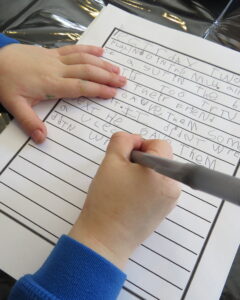
Planning Writing Lessons for Grades K-5
If you take time to read this post, all other writing lessons that I’ve posted will be easy to follow and use.
If you are a school teacher or home-school parent, I hope so much that you will find these guided writing lessons helpful, quick go-to’s for any time that you need a writing lesson.
Free PDF Printouts
The prompts are categorized by Genres and Themes which include holidays, seasons and animals for your convenient perusal. They all come with a FREE PDF version of the guided writing lesson for you to print out and use.
Write and Finish Often
My goal is to get kids to write often. I want children to be able to complete a short story within a 30-60 minute time period. This way they can regularly feel the satisfaction of finishing. In addition, they can often celebrate their work by adding an easy art accent, sharing their story and playing writing games.
There is definitely a time to focus on the complete writing process, drafting, writing, revising and editing. But that is not my goal here. For young children, I think spending too much time on one story, every time, can feel arduous for them.
In addition to guided writing lessons, it’s very important to give children many opportunities to free write independently with no guidance or structure. Both exercises, guided writing and free writing, are useful to the children.
Use Pens
We write with pen.
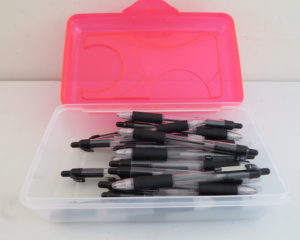
For these guided writing lessons, their first draft is their final draft. I teach the children ahead of time that if they write something they don’t like, to “simply cross it off with one line and keep going. Don’t color a huge storm cloud.”
I give wider lines for younger writers (Grades K-2) and narrow lines for more advanced writers (Grades 2-7)

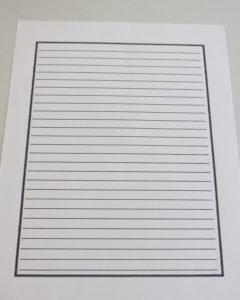
The PreK-K page doesn’t have any lines and is good for very early writers who may only write one or two words or sentences.
The Goal for Each Writing Lesson
In summary, the goal for each writing lesson is to:
- Stimulate creative thinking
- Teach children the skill and habit of organizing their ideas
- Provide a fun platform for the students to regularly and often practice simple sentence structure, spelling and vocabulary.
Differentiation at Best
When I teach the year round writing workshops and camps, children ages 5-11 are in the same class. So, I write the plans with differentiation in mind.
These guided writing lessons can easily be applied to a regular classroom setting because in most cases, not all students are exactly on grade level with their writing. In a 3rd Grade classroom, some students might be writing at a 1st, 2nd, 3rd, 4th, or 5th Grade level. These lessons were designed with the heart for EVERY child to feel successful in writing their own story.
One 5th Grader’s Story
For example, this past school year, I had the absolute privilege of working with a 5th Grade boy who struggled terrible with writing. I only taught him for one hour each week. At the beginning of the school year, he wasn’t able to write a single word on his paper by himself.
In fact, the only way I could get him to write was to stand next to him, ask him what he wanted to write and then verbally spell out each word for him. There were many times when I had to speak out proper letter strokes as well to help him move along.
The general expectation that I have for 5th Graders is to write about 25 sentences for each guided writing lesson (5 sentences per section). You’ll learn how this works below!
So, at the beginning of the year, this student couldn’t write one sentence independently. However, by the end of the year, he was able to write 2-3 sentences per section on his own! That’s after only working with him one hour per week from September-March. Needless to say, I was so proud of him!
Most importantly, he is proof that the strategy behind the guided writing lessons that I post can work for even our most struggling writers.
Home-school Families
Additionally, these writing lessons are ideal for parents who are homeschooling students in Grades K-5. A parent can conduct the same writing prompt with a 1st, 3rd and 5th grader at the same time.
For example, below there are three sample writing pieces from the Candy Corn-Opinion writing lesson. These three students attend my after school writing class. They were in the same class at the same time.
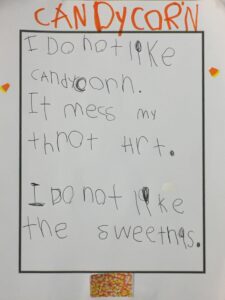
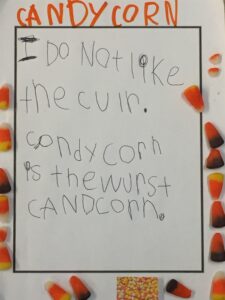
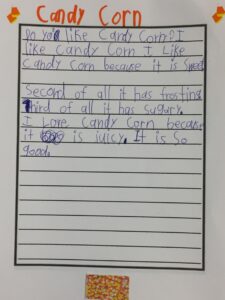
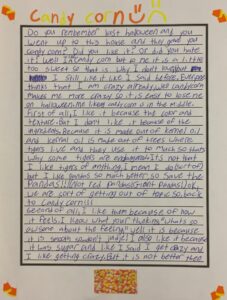
HERE’S HOW IT WORKS
These 5 steps are specified in each guided writing lesson that I post on this website.
Tell the Story Line
- First, begin each lesson by telling the genre and story line. If there is specific vocabulary or a specific spelling pattern that you and your students are focusing on, introduce it at this time as well.
Brainstorm
2. Second, brainstorm ideas with the students. (The following pictures were taken when I taught the “Q-U” Queen Fairy Tale Writing Prompt) We were focusing on the spelling pattern ‘qu’ and brainstorming problems for our story.
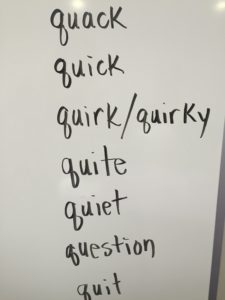

Show the 5 Sections
3. Next, show the 5 sections of the writing prompt. These 5 sections are crucial to helping children organize their stories.
For example, a creative story will have an introduction, beginning, middle, end and conclusion.
A persuasive piece will have an introduction, reason 1, reason 2, reason 3 and conclusion.
Regardless of the genre (except for poetry), I always divide the writing prompt into 5 sections.
Teaching children to anticipate and prepare to write 5 sections regularly sets them up for lifelong writing success (i.e. high school and college writing). A college thesis will typically have 5 sections. The only difference is that when we’re older, we’re able to elaborate using more words.
Show the Expectation
4. Fourth, show how many sentences students should try to write for each section. On the top corner of the white board, write
Grades K-1st–1 Sentence for each section
2nd Grade–2 Sentences
3rd Grade–3 Sentences
4th Grade–4 Sentences
5th Grade–5 Sentences
This is a very important step. Showing the five sections and a general idea of how many sentences each age group should write helps the students anticipate their entire story and keep their ideas organized.
If you are homeschooling students in grades K-5 and use these lessons, over time, your children will catch onto the pattern. Your 1st Grader will get used to writing 5 sentences per story, your 3rd Grader about 15 sentences and your 5th Grader about 25 sentences.
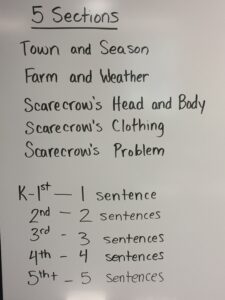
If I skip this step, students will tend to write too little leaving out interesting details, or write way too much creating a run on story that doesn’t have a clear beginning, middle and end.
Again, if your child is older and struggles with writing or is just getting started, have him or her start off by writing 2 sentences per section. As time goes on, work up to 3 sentences per section and so on.
Writing
5. Last, we write!
When it comes time to write, I explain the general content of the first section, then give the students time to write their own words.
Next, we move on to the 2nd section. I explain the general content that should come next and they write their own ideas. We continue through each of the 5 sections that way.
Young or Struggling Writers
For the youngest writers or those with specific needs, I will ask them their ideas. I will then simplify their ideas into sentences that they can write and read. I write these sentences on the board for them to copy (while the older children are writing independently).
Some instructors argue against copying. I’m not a fan of children copying just any text for the sake of copying. If children are going to copy a sentence, it should be a sentence that they are learning to read (such as sight word sentences) or a sentence they have spoken and want to write.
Otherwise, students are copying content without knowing what it says. I have found that copying random sentences from books, for example, isn’t very useful or strategic.
Lastly, copying words that children say and can read at a young age creates an opportunity for them to practice their letter strokes, spell common sight words and complete a story. Most importantly, it enables them to finish a piece that they can read. You should see how proud and excited the small children are to read their simple stories to their parents!
Older or Advance Writers
For the independent writers, I offer my help continuously. The campers will often hear me say, “How’s everyone doing? Does anyone need anything? I’m here to help.” I tell them that if they want to know how to spell something to just ask. Then, I write it on the side of the board for them (and others) to see.
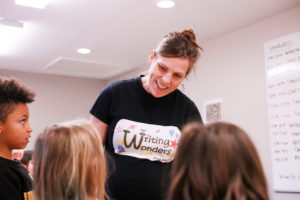
Above all, I want the students to enjoy getting their ideas on paper. I don’t want them to stumble or get stuck over spelling or writer’s block. I’m standing and walking around the room, quick to help and serve as a resource anytime they ask for it.
I know in my heart that by doing this often and regularly, they’re going to develop good grammar and spelling skills, build their vocabulary and gradually move into independent, confident writing.
Conducting These Lessons at Home
If you are homeschooling students in Grades K-5, you can conduct the same lessons at your kitchen table. Imagine sitting at the kitchen table with your children next to or across from you. Each child has an extra piece of paper in front of them. If they ask you how to spell a word, you can write it down on their piece of paper. Or, if you have a large whiteboard nearby, you can write the 5 sections and any words they want you to spell there.
Saving Time!
Sitting with your children while they complete the writing prompt will save you so much time! First of all, the 30-60 minutes you take to sit with them will ensure they feel supported. As a result, they will be able to finish and feel more confident in their ability to start and finish a story!
Second, when homeschooling students in Grades K-5 and conducting these lessons, you can check “writing” off your list for all of your children. All of your children will have completed their writing lesson in the same 30-60 minutes.
Lastly, instead of spending a day begging and pleading for a child to finish a vague writing prompt on his or her own, you can create this rhythm of completing writing prompts in 30-60 minutes, 1-3 times per week. Your children will feel excited about their story and you will be spared the stress of nagging and ending the day with unfinished work.
Independent Writing
Eventually, there will come a time when you can give older children the 5 sections to a writing prompt and they will be able to write their 15-25 sentences independently if you need them to.
Ultimately, this sets them up for comfortable and confident writing that will carry over into Middle School, High School and College or the workplace.
RECAP
So, to recap, a 30+ minute writing lesson will look something like this:
- First, introduce the genre, story line and any spelling pattern or vocabulary that you want to focus on.
- Second, the children brainstorm their ideas. I write their responses on the board.
- Third, show the 5 sections on the board. Briefly, explain each section.
- Fourth, write out how many sentences each grade level should generally write.
- Fifth, hand out lined writing paper and pens.
- Sixth, explain section one. Give the children time to write. Set aside one section of the board to write a model story for the small children or struggling writers to copy (if they need it).
- Seventh, explain section two. Give the children time to write.
- Eighth, explain section three. Give the children time to write.
- Ninth, explain section four. Give the children time to write.
- Tenth, explain section five. Give the children time to write.
Print the Outline
Here’s the outline for you to print out and use.
For a 60-90 minute block of time, you can add:
11. An easy art accent.
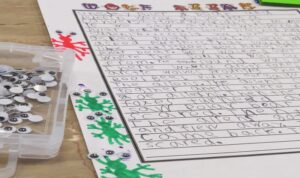
12. Time for students to share their story while the rest finish.
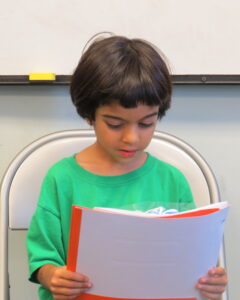
13. Play 1-3 writing games depending on the time you have left.
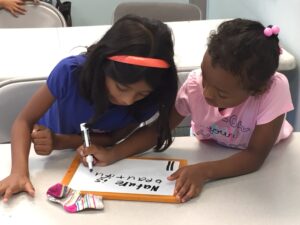
Below is a list of writing prompt lesson plans. You can begin browsing ideas by:
GENRE


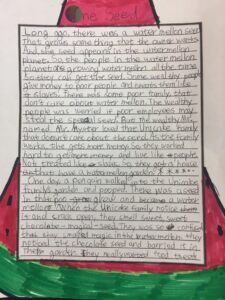
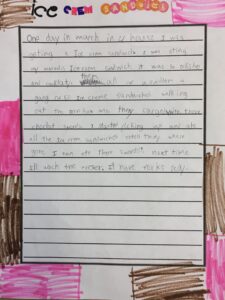
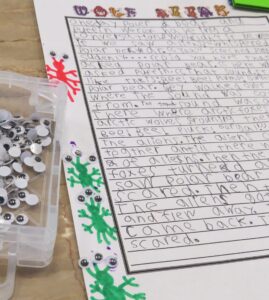
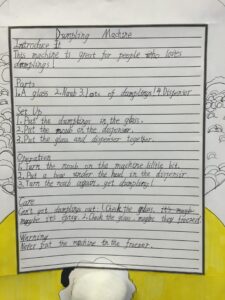




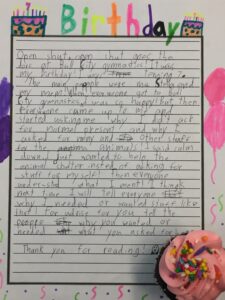


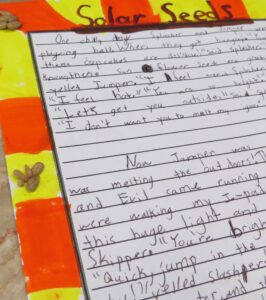
HOLIDAYS/SEASONS
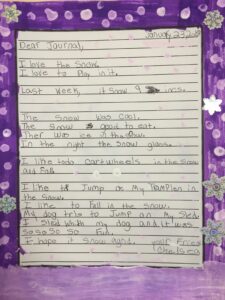
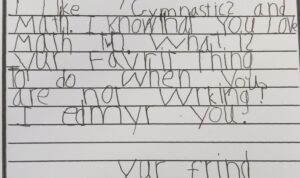
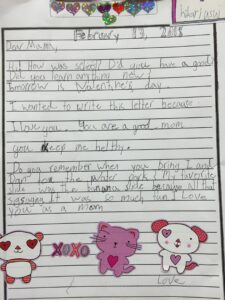

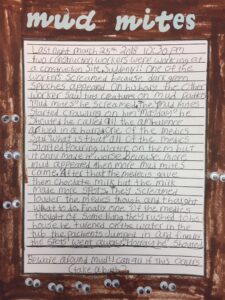
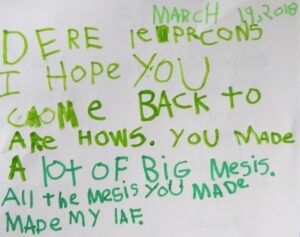

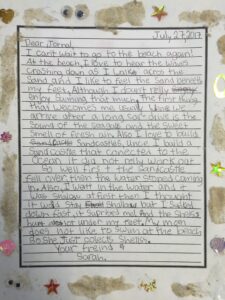
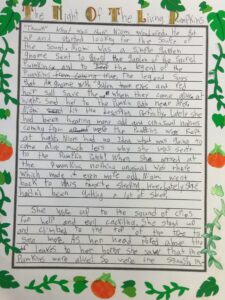
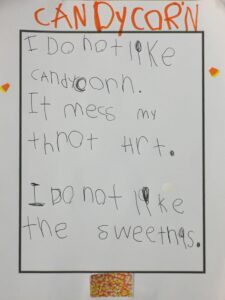
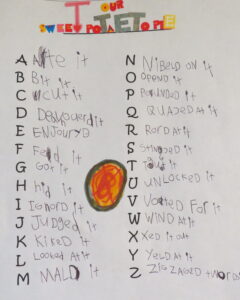

ANIMALS

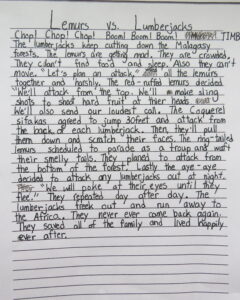

Subscribe and Communicate
If you’d like to receive new writing prompt and game ideas regularly, you can sign up for my FREE monthly newsletter below!
Or, if you have questions about homeschooling students in Grades K-5, subscribe to my FREE monthly newsletter and communicate with me via email. I’m happy and eager to support families who are homeschooling!
A Little Laugh
This was a long post, finish it off by watching this charming 5 minute video titled, “Kids Write Stan Walker’s New Song”.
